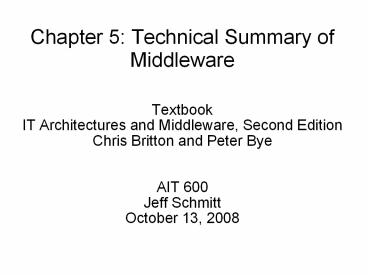Chapter 5: Technical Summary of Middleware - PowerPoint PPT Presentation
1 / 11
Title:
Chapter 5: Technical Summary of Middleware
Description:
Chapter 5: Technical Summary of Middleware Textbook IT Architectures and Middleware, Second Edition Chris Britton and Peter Bye AIT 600 Jeff Schmitt – PowerPoint PPT presentation
Number of Views:139
Avg rating:3.0/5.0
Title: Chapter 5: Technical Summary of Middleware
1
Chapter 5 Technical Summary of Middleware
- Textbook
- IT Architectures and Middleware, Second Edition
- Chris Britton and Peter Bye
- AIT 600
- Jeff Schmitt
- October 13, 2008
2
(No Transcript)
3
Middleware Elements
- Communications link
- The Protocol
- Programmatic Interface
- Data Presentation Common data format
- Server Control
- Naming and directory services
- Security
- Systems management
4
(No Transcript)
5
Vendor Architectures
- Vendor Platform Architecture
- Vendor-distributed Architecture
- Using Vendor Architectures
- Positioning
- Strawman for user target audience
- Marketing
- Implicit architectures
6
(No Transcript)
7
(No Transcript)
8
Middleware Interoperability
9
(No Transcript)
10
Summary
- Middleware products classified
- Technology Client/server, peer-to-peer, push
- Integrity message integrity (delivery
guarantee), transaction integrity - Differences among products Huge variety in API
- SOAP dictates basic message transfer facility
- but allows enhancement by headers or protocol
layered on top of SOAP - No standard API, and some APIs restrict the Web
services functionality - Vendor products
- Moving from tightly coupled to loosely coupled
middleware - .NET (more PL) and J2EE (more platforms) are
remarkably similar, same basic notions of tiering
and just-in-time compilation
11
Summary
- Middleware interoperability
- Possible and often important
- Important technical issue is integrity, not to
lose integrity when moving from one middleware
technology to another - Message and transaction integrity can be
implemented by two-phase commit transactions on
the middleware hub - Applications can check on integrity, checking to
see if last transaction was done, reversal
transactions to undo previous work if needed































